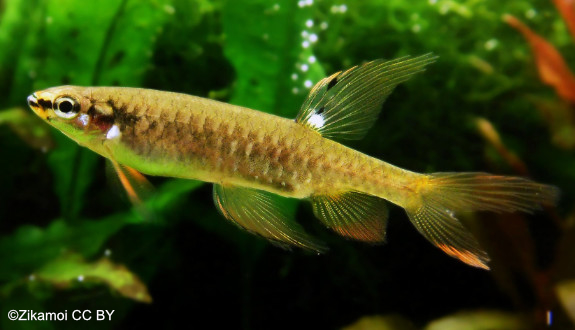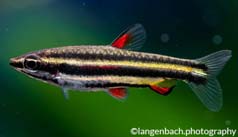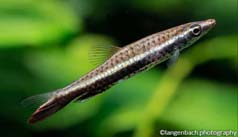

Alternative species (click on the thumbnail to see the card)
Names
Scientific name
Copella arnoldi
Copeina arnoldi
Common name
Splash tetra
Splashing tetra
Spraying characin
Jumping characin
Spotted characin
Spritzsalmler (DE)
Origin

Origin: Guyana, Suriname, Brazil, Venezuela
Biotope: Amazonian
Dimorphism
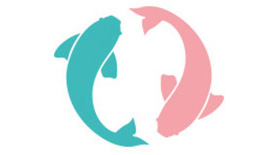
The male is larger and more colorful than the female. Their fins are also thinner.
Group
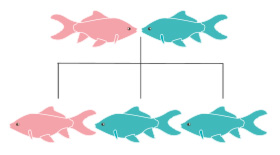
Lebiasinidae
Volume

80 L / 18 imp gal / 21 US gal
Parameters

T°: 25 to 26°C or 77 to 79°F
pH: 6.5 to 7
Hardness: 5 to 15°dGH
Difficulty

Easy
Size

6 to 8cm (2.4 to 3.2")
Longevity

5 years
Living zone
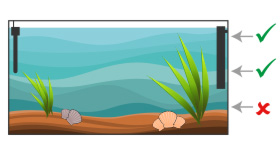
Top and middle
Individuals

6
Food
How to feed the Splash tetra?
Food
How to feed the Splash tetra?
This omnivorous fish is easy to feed. It accepts live (preferred) or frozen prey, as well as dry flakes. Its favorite treat? Small flies! Beware, it happens that these fish jump at the occasion of their meals.
Behavior
What kind of behavior does the Splash tetra have?
Behavior
What kind of behavior does the Splash tetra have?
It is a discreet and peaceful fish even if it is rather lively. It lives just below the surface of the water and jumps on many occasions: eating, breeding...
The male becomes territorial during the reproduction period, where he takes care to chase away intruders that would pass under his leaf.
Cohabitation
Who can live with the Splash tetra?
Cohabitation
Who can live with the Splash tetra?

With a developed gregarious instinct, this small fish likes to live in groups. The minimum for proper maintenance starts at 6 specimens, but a group of 10 is ideal.
It is a species that is suitable for community aquariums because the Copella does not care about other species at all. For example, cohabitation with small Characidae, Dwarf Cichlids (which live at the bottom of the aquarium), Dwarf Corydoras, Pencilfish or even small freshwater shrimp goes very well. On the other hand, the small shyness of the Copella prevents cohabitation with larger or restless fish.
Breeding
How to breed the Splash tetra?
Breeding
How to breed the Splash tetra?
The breeding of this species is quite easy. Stimulate spawning by feeding live or frozen prey such as daphnia, bloodworms or mosquito worms.
Set up a small breeding aquarium (50 cm or 20" long will suffice) and fill it with water from the main aquarium. Put broad-leaved plants such as Echinodorus or Anubias whose leaves will be slightly above the water level. Cover the aquarium with glass and make sure there is still some space between the water surface and the glass covering the aquarium.
Spawning is quite peculiar as the male jumps out of the water to moisten the leaf. Then the female joins him in this behaviour, and the pair jumps together until they are stuck to the leaf or glass. They can jump up to 10 cm or 4". Don't worry, this will only last about ten seconds: time for our lovers to lay the eggs and fertilize them, and they will return to the water (the female first, then the male). They will perform this exercise many times, each time expelling about ten eggs. In the end, a clutch can consist of 100 to 200 eggs gathered in clusters.
After the laying, the male chases the female (you can remove it from the breeding aquarium) and starts a fascinating work: he sends water on the leaf every 30 seconds or so thanks to a sudden movement of the tail: that's where the name "sprinkler" comes from! In this way, the eggs are constantly moist. He also protects his eggs by chasing away any intruder from the area under the leaf. It can then be aggressive.
Incubation lasts from 48 to 60 hours and then the eggs hatch. The care of the male stops there and you can put him back in the overall aquarium. The fry then fall into the water when the male is watered. The yolk sac (food reserve for the first days after birth) is resorbed in 36 to 48 hours and then it is free swimming for the fry. They concentrate below the surface: add floating plants to reassure them.
Another possible protocol: plants attached to suction cups can also be used. They have the advantage of being able to easily recover the larvae to place them in a rearing aquarium (this must be done just before they mature).
Feeding of the fry: rotifers, infusoriae and then nauplia of artemia.
Its aquarium
Which aquarium for the Splash tetra?
Its aquarium
Which aquarium for the Splash tetra?
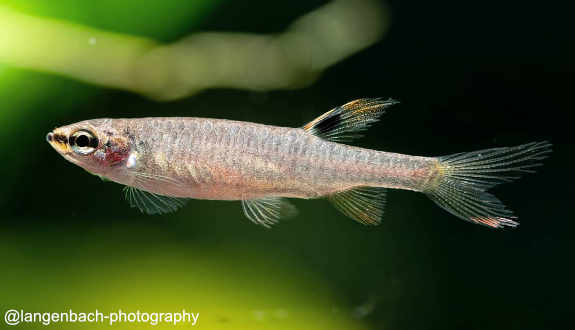
In the wild, this fish lives in stagnant or very slow-moving waters where vegetation is very abundant.
The Coppella appreciates black water loaded with tannin. To obtain such a water quality, you can filter on peat, or litter the ground with decomposing dead leaves (catappa, beech, oak...) or alder fruits. Another benefit: the pH is slightly acidified by these elements.
Floating plants reassure him and allow him to hide: Ceratopteris thalictroides, Salvinia or Pistia are welcome. In general, this fish likes well planted aquariums.
Excellent jumpers, it is even a way of life for this species! You may find your fish on the ground if you do not cover your aquarium... It is also advisable to leave at least 10 cm or 4" between the surface of the water and the lighting so that they do not end up grilled either...
The water quality must always be optimal. For this, choose a soft filtration (Copella does not appreciate the current that exhausts it) and direct the filter discharge against a wall of the tank. Also change the water by 20% every 15 days. If your fish seem inert or if they are constantly hidden, it is a sign of a small degradation of the water quality. A partial water change will solve the problem.
Good To know
Find all additional information!
Good To know
Find all additional information!
The Copella arnoldi is a cousin of the pencilfish!
Yours photos!
Comments
Sort by:
Please login to post comments
